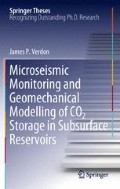Abstract
Microseismic monitoring provides information about the geomechanical deformation occurring in and around the reservoir. As such, the interpretation of microseismic activity can be greatly improved by geomechanical modelling. Geomechanical models commonly use finite element techniques to simulate the deformation caused by pore pressure changes in the reservoir. Injection of \(\hbox{CO}_2\) will increase the pore pressure in the reservoir. This represents the loading for the geomechanical model, which computes the deformation both inside and around the reservoir. By examining the stress evolution it is possible to identify areas in and around the reservoir where fractures are likely to form or be reactivated. In this chapter I use a relatively novel technique where a geomechanical model is coupled to a fluid-flow simulator. This allows changes in pore pressure to be passed directly to the geomechanical model, and changes in porosity and permeability to be returned to update the fluid model. The modelling method has been developed by the Integrated Petroleum Engineering, Geomechanics and Geophysics (IPEGG) consortium. In this chapter I introduce the modelling technique and demonstrate it with several simple numerical simulations. I use these to examine how factors such as the reservoir geometry and material properties affect the stress evolution during \(\hbox{CO}_2\) injection.
Even the self-assured will raise their perceived self-efficacy if models teach them better ways of doing things. Albert Bandura
Access this chapter
Tax calculation will be finalised at checkout
Purchases are for personal use only
References
Crook AJL, Willson SM, Yu JG, Owen DRJ (2006) Predictive modelling of structure evolution in sandbox experiments. J Struct Geol 28(5):729–744
Dean RH, Gai X, Stone CM, Minkoff SE (2003) A comparison of techniques for coupling porous flow and geomechanics. In: Proceedings of the 17th SPE reservoir simulation symposium, SPE 79709
Hatchell P, Bourne S (2005) Rocks under strain: strain-induced time-lapse time shifts are observed for depleting reservoirs. Leading Edge 24:1222–1225
Longuemare P, Mainguy M, Lemonnier P, Onaisi A, Gerard C, Koutsabeloulis N (2002) Geomechanics in reservoir simulation: overview of coupling methods and field case study. Oil Gas Sci Technol 57(5):471–483
Mavko G, Mukerji T, Dvorkin J (1992) The rock physics handbook. Cambridge University Press, Cambridge
Minkoff SE, Stone CM, Bryant S, Peszynska M (2004) Coupled geomechanics and flow simulation for time-lapse seismic modeling. Geophysics 61(1):200–211
Onuma T, Ohkawa S (2009) Detection of surface deformation related with \(\hbox{CO}_{2}\) injection by DInSAR at In Salah, Algeria. Energy Procedia 1:2177–2184
Rutqvist J, Vasco DW, Myer L (2009) Coupled reservoir-geomechanical analysis of \(\hbox{CO}_{2}\) injection at In Salah, Algeria. Energy Procedia 1:1847–1854
Segura JM, Fisher QJ, Crook AJL, Dutko M, Yu J, Skachkov S, Angus DA, Verdon JP, Kendall J-M (2011) Reservoir stress path characterization and its implications for fluid-flow production simulations. Petroleum Geosciences, accepted
Terzaghi K (1943) Theoretical soil mechanics. Wiley, New York
Vasco DW, Ferretti A, Novali F (2008) Reservoir monitoring and characterization using satellite geodetic data: interferometric synthetic aperture radar observations from the Krechba field, Algeria. Geophysics 73(6):WA113–WA122
Author information
Authors and Affiliations
Corresponding author
Rights and permissions
Copyright information
© 2012 Springer Verlag-Berlin Heidelberg
About this chapter
Cite this chapter
Verdon, J.P. (2012). Geomechanical Simulation of \(\hbox{CO}_2\) Injection. In: Microseismic Monitoring and Geomechanical Modelling of CO2 Storage in Subsurface Reservoirs. Springer Theses. Springer, Berlin, Heidelberg. https://doi.org/10.1007/978-3-642-25388-1_5
Download citation
DOI: https://doi.org/10.1007/978-3-642-25388-1_5
Published:
Publisher Name: Springer, Berlin, Heidelberg
Print ISBN: 978-3-642-25387-4
Online ISBN: 978-3-642-25388-1
eBook Packages: Earth and Environmental ScienceEarth and Environmental Science (R0)

